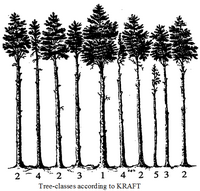Tree sociological position
| Attention!: |
This article must be enhanced to meet the AWF-Wiki quality standards! Please visit the Discussion Page of this article for details! |
The sociological position of single tree is an important factor which determines the growth and production potential of a tree. According to the sociological position, a tree is commonly assigned in one out of 5 categories as predominant, dominant, co-dominant, dominated and suppressed (Figure 1) which are also referred to classes according to Kraft.
The terms dominant, co-dominant and sub-dominant refer to the fact that the particular tree crown maintains a position in the upper stratum of the stand. The dominant group of trees or shrubs receives the full light from above and partly from the side and usually has larger sizes than the average trees in the stand. The other categories gradually receive less light and occupy less space in the upper crown layer. Usually, dominant trees are the most vigorous and suppressed trees have little prospects of surviving (depending on the species).
